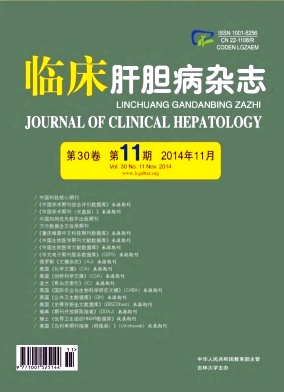|
[1]GAO GY, GU Q.Research advances in traditinal chinese medicine treatment of non-alcoholic fatty liver disease[J].J Changchun Univ Tradit Chin Med, 2012, 28 (2) :360-362. (in Chinese) 高广毅, 顾勤.非酒精性脂肪肝的中医药治疗研究进展[J].长春中医药大学学报, 2012, 28 (2) :360-362.
|
|
[2]DANIEL H, MOGHADDAS GA, BERRY D, et al.High-fat diet alters gut microbiota physiology in mice[J].ISME J, 2014, 8 (2) :295-308.
|
|
[3]CARICILLI AM, SAAD MJ.The role of gut microbiota on insulin resistance[J].Nutrients, 2013, 5 (3) :829-851.
|
|
[4]VOLYNETS V, KPER MA, STRAHL S, et al.Nutrition, intestinal permeability, and blood ethanol levels are altered in patients with nonalcoholic fatty liver disease (NAFLD) [J].Dig Dis Sci, 2012, 57 (7) :1932-1941.
|
|
[5]CSAK T, VELAYUDHAM A, HRITZ I, et al.Deficiency in myeloid differentiation factor-2 and toll-like receptor 4 expression attenuates nonalcoholic steatohepatitis and fibrosis in mice[J].Am J Physiol Gastrointest Liver Physiol, 2011, 300 (3) :433-441.
|
|
[6]JING X, LI H, DENG XL, et al.Research advances in genetic variation and non-alcoholic fatty liver disease[J].Chin J Clin Pharmacol Ther, 2012, 17 (8) :950-956. (in Chinese) 景贤, 李慧, 邓晓兰, 等.遗传变异与非酒精性脂肪肝病的研究进展[J].中国临床药理学与治疗学, 2012, 17 (8) :950-956.
|
|
[7]DAPITO DH, MENCIN A, GWAK GY, et al.Promotion of hepatocellular carcinoma by the intestinal microbiota and TLR4[J].Cancer Cell, 2012, 21 (4) :504-516.
|
|
[8]HENAO MJ, ELINAV E, JIN C, et al.Inflammasome-mediated dysbiosis regulates progression of NAFLD and obesity[J].Nature, 2012, 482 (7384) :179-185.
|
|
[9]YE D, LI FY, LAM KS, et al.Toll-like receptor-4 mediates obesity-induced non-alcoholic steatohepatitis through activation of X-box binding protein-1 in mice[J].Gut, 2012, 61 (7) :1058-1067.
|
|
[10]ZHU L, BAKER SS, GILL C, et al.Characterization of gut microbiomes in nonalcoholic steatohepatitis (NASH) patients:a connection between endogenous alcohol and NASH[J].Hepatology, 2013, 57 (2) :601-609.
|
|
[11]BAKER SS, BAKER RD, LIU W, et al.Role of alcohol metabolism in non-alcoholic steatohepatitis[J].PLoS One, 2010, 5 (3) :e9570.
|
|
[12]DEKANEY CM, von ALLMEN DC, GARRISON AP, et al.Bacterial-dependent up-regulation of intestinal bile acid binding protein and transport is FXR-mediated following ileo-cecal resection[J].Surgery, 2008, 144 (2) :174-181.
|
|
[13]SAYIN S, WAHLSTROM A, FELIN J, et al.Gut microbiota regulates bile acid metabolism by reducing the levels of tauro-betamuricholic acid, a naturally occurring FXR antagonist[J].Cell Metab, 2013, 17 (2) :225-235.
|
|
[14]FOUTS DE, TORRALBA M, NELSON KE, et al.Bacterial translocation and changes in the intestinal microbiome in mouse models of liver disease[J].J Hepatol, 2012, 56 (6) :1283-1292.
|
|
[15]DEVKOTA S, WANG Y, MUSCH MW, et al.Dietary-fat-induced taurocholic acid promotes pathobiont expansion and colitis in Il10–/–mice[J].Nature, 2012, 487 (7405) :104-108.
|
|
[16]EREN F, KURT R, ERMIS F, et al.Preliminary evidence of a reduced serum level of fibroblast growth factor 19 in patients with biopsy-proven nonalcoholic fatty liver disease[J].Clin Biochem, 2012, 45 (9) :655-658.
|
|
[17]ALISI A, CECCARELLI S, PANERA N, et al.Association between serum atypical fibroblast growth factors 21 and 19 and pediatric nonalcoholic fatty liver disease[J].PLoS One, 2013, 8 (6) :e67160.
|
|
[18]KONG B, LUYENDYK JP, TAWFIK O, et al.Farnesoid X receptor deficiency induces nonalcoholic steatohepatitis in low-density lipoprotein receptor-knockout mice fed a high-fat diet[J].Pharmacol Exp Ther, 2009, 328 (1) :116-122.
|
|
[19]BECHMANN LP, KOCABAYOGLU P, SOWA JP, et al.Free fatty acids repress small heterodimer partner (SHP) activation and adiponectin counteracts bile acid-induced liver injury in superobese patients with nonalcoholic steatohepatitis[J].Hepatology, 2013, 57 (4) :1394-1406.
|
|
[20]KAY HY, KIM WD, HWANG SJ, et al.Nrf2 inhibits LXRα-dependent hepatic lipogenesis by competing with FXR for acetylase binding[J].Antioxid Redox Signal, 2011, 15 (8) :2135-2146.
|
|
[21]TOSHINORI K, YUJI T, YOSHIZUMI K, et al.Role of Nrf2 in the alteration of cholesterol and bile acid metabolism-related gene expression by dietary cholesterol in high fat-fed mice[J].J Clin Biochem Nutr, 2014, 54 (2) :90-94.
|
|
[22]WANG YD, CHEN WD, YU D, et al.The G-protein-coupled bile acid receptor, Gpbar1 (TGR5) , negatively regulates hepatic inflammatory response through antagonizing nuclear factor kappa light-chain enhance of activated B cells (NF-kappa B) in mice[J].Hepatology, 2011, 54 (4) :1421-1432.
|
|
[23]CHEN WD, YU D, FORMAN BM, et al.Deficiency of G-protein-coupled bile acidreceptor Gpbar1 (TGR5) enhances chemically induced liver carcinogenesis[J].Hepatology, 2013, 57 (2) :656-666.
|
|
[24]KWOK RM, TORRES DM, HARRISON SA.Vitamin D and nonalcoholic fatty liver disease (NAFLD) :Is it more than just an association?[J].Hepatology, 2013, 58 (3) :1166-1174.
|
|
[25]ROTH CL, ELFERS CT, FIGLEWICZ DP, et al.Vitamin D deficiency in obese ratsexacerbates nonalcoholic fatty liver disease and increases hepatic resistinand Toll-like receptor activation[J].Hepatology, 2012, 55 (4) :1103-1111.
|
|
[26]DING N, YU RT, SUBRAMANIAM N, et al.A vitamin D receptor/SMAD genomiccircuit gates hepatic fibrotic response[J].Cell, 2013, 153 (3) :601-613.
|
|
[27]ELIADES M, SPYROU E, AGRAWAL N, et al.Meta-analysis:vitamin D and non-alcoholic fatty liver disease[J].Aliment Pharmacol Ther, 2013, 38 (3) :246-254.
|







 DownLoad:
DownLoad: